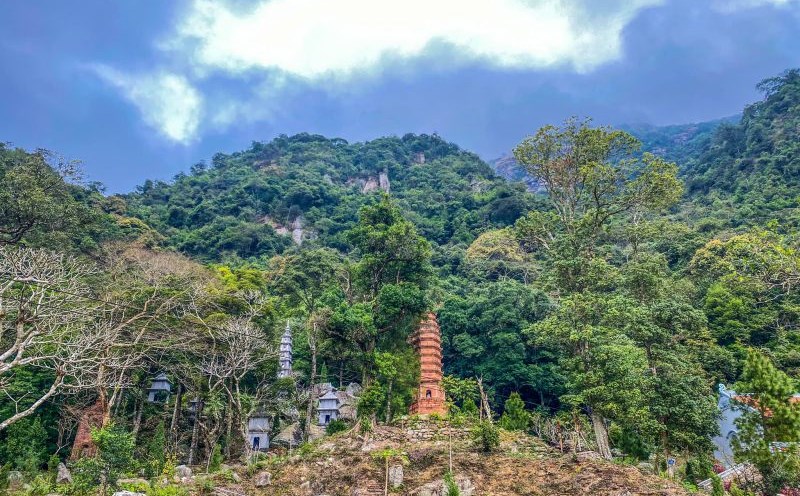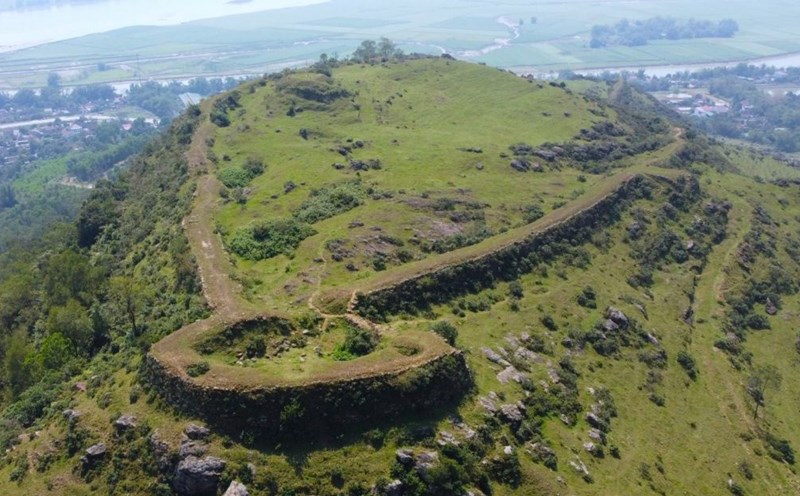Nam Gioi Mountain in the history of Vietnamese Buddhism
One of the unique features of Nam Gioi Mountain is its role in the history of spreading Buddhism to Vietnam. According to one view, Buddhism was introduced to our country from the 1st to the 2nd centuries BC, and the center of its acceptance is Dau Pagoda (Phap Van Pagoda), now in Thanh Khuong ward, Thuan Thanh town, Bac Ninh province. The second view is that Buddhism was passed on to our country in the Southern Gioi mountains, associated with the legend that Chu Dong Tu and princess Tien Dung once established Quynh Vien on this mountain to practice, creating a connection between folk beliefs and the development of Buddhism in Vietnam.
The book "Nam nhat thong chi" reads: "Nam Gioi hill in Duong Luat commune towards the Northeast of the city. It is called Nam Gioi mountain, because in the past, the south of the sol gate bordered Chiem Thanh. On the mountain there is a pond, called Tam pond, with endless depths, next to the pond there is an ancient house foundation, called "Quynh Vien", according to Chu Dong Tu's legend, cultivated here.
In addition, the poem by King Le Thanh Tong when traveling to the South also mentioned this famous paint: "Danh Son do Truyen Quynh Vien" (Danh Son still mentions Quynh Vien mountain from ancient times). These records not only affirm the important position of Nam Gioi Mountain in religious history but also add to the mystery of this landscape.
Border Guard Border Guard Border Guard
Nam Gioi Mountain is not only a majestic natural landscape but also a place that preserves many unique cultural, religious and historical values. According to the book "Nghe An Ky" by Bui Duong Lich, a person with a maternal hometown and who lived here for a while, said: "In the past, the south of our country bordered the Chiem Thanh water, so the name was Nam Gioi mountain. The waterway goes from Nhat Le mountain, high and beautiful. The highest place in the Northeast of the mountain is the dragon's head. Below the mountain is a mountain range like a dragon's nose. On the left and right sides are two round rocks shaped like dragon's eyes. A round mountain suddenly emerged under the nose like a dragon's nose ( standard crab). At the top of the nose is a sky pond with a few samples as big as a dragon's mouth, deep as a depression. The four sides of the pond are muddy and cannot be reached. On both sides of the pond, there are two arms that look like dragon beards. The pond water flows windingly to the North, out to the sea and then down. The lower left mountain branch runs out to the sea when suddenly a peak suddenly appears, blocking it, the waves hit it like a million thunderstorms, called Long Ngam peak".
In addition to cultural and legendary values, Nam Gioi Mountains also play an important role in history. According to "Dai Nam nhat Thong Chi", in 1025, King Ly Thai To issued a notice to establish Dinh Phien camp here to protect the southern border of Dai Viet, when this area was still adjacent to Chiem Thanh. The ancient houses on the mountain are said to be traces of the Dinh Phien camp, not relics from the Chu Dong Tu era as folk legend has been said.
The northwest of the mountain also has a temple worshiping Vu Chuc Cong Le Khoi, a famous general of the Later Le Dynasty, with a stone engraved by explorer Nguyen Nhu Do. In the area, there is also the Voi Quy Temple built during the Tran Dynasty, the temple of Saint Ho Khuoc - a talented general who had great contributions to the resistance wars. These relics demonstrate the important role of Nam Gioi Mountains in protecting territory and developing ethnic culture.

A famous port trader
Geographically, Nam Gioi Mountain is located near the gate of supply, a bustling trading port in ancient times. Cua Sot is the intersection of the Ha Vang River, consisting of two branches, the Nghen River and the Rao Cai River. Inside the Tot Gate is the Dragon Vung, a windy area with a terrain like a basin, considered the center of port trade. This place used to be a anchorage for boats from all over to trade, as well as for local residents. On the northern bank of Dragon Vung is Giang Ha hamlet, where houses are close together, with the characteristics of an ancient town.
The book "Dai Nam nhat Thong Chi" describes the Son Gate: "The gate is 37 bays wide (157m), the tide is 8 bays (3.4m) deep, the tide is 5 bays (2.1m) deep. In the past, Northern boats to our country often stayed here. According to the book "Nghe An Ky", there is also a record of a deep estuary. In the past, the merchant boats of the Taos all entered that gate."
In addition, Nam Gioi Mountain is also famous for its abundant freshwater, a valuable resource for local residents. According to Bui Duong Lich, this is one of the three famous freshwater streams in the region, with fresh and cool water, especially exploited in the summer to serve the needs of the people. Sites such as Hieu Hieu stream, Am stone, Ngua stone and small streams on the mountain not only bring practical value but also contribute to enriching the natural landscape of the area.
Another special feature of Nam Gioi Mountain is the diversity of locations and shapes of rocks, each associated with folktales or unique natural features. For example, Hon Lo, Hon Moi or Hon Tuong all have strange shapes, stimulating human imagination. Names such as "Dragon Stone", "Haven Stone", "Da Giong" or "Dragon - Egg Ga" also reflect the richness of the ecosystem and geology here.
Through ancient documents and field surveys, it can be affirmed that Nam Gioi Mountain is not only a natural landscape but also an important cultural and historical heritage. With majestic natural landscapes, strategic geographical location and profound cultural values, Nam Gioi Mountain deserves to be a destination not to be missed when exploring Ha Tinh.











